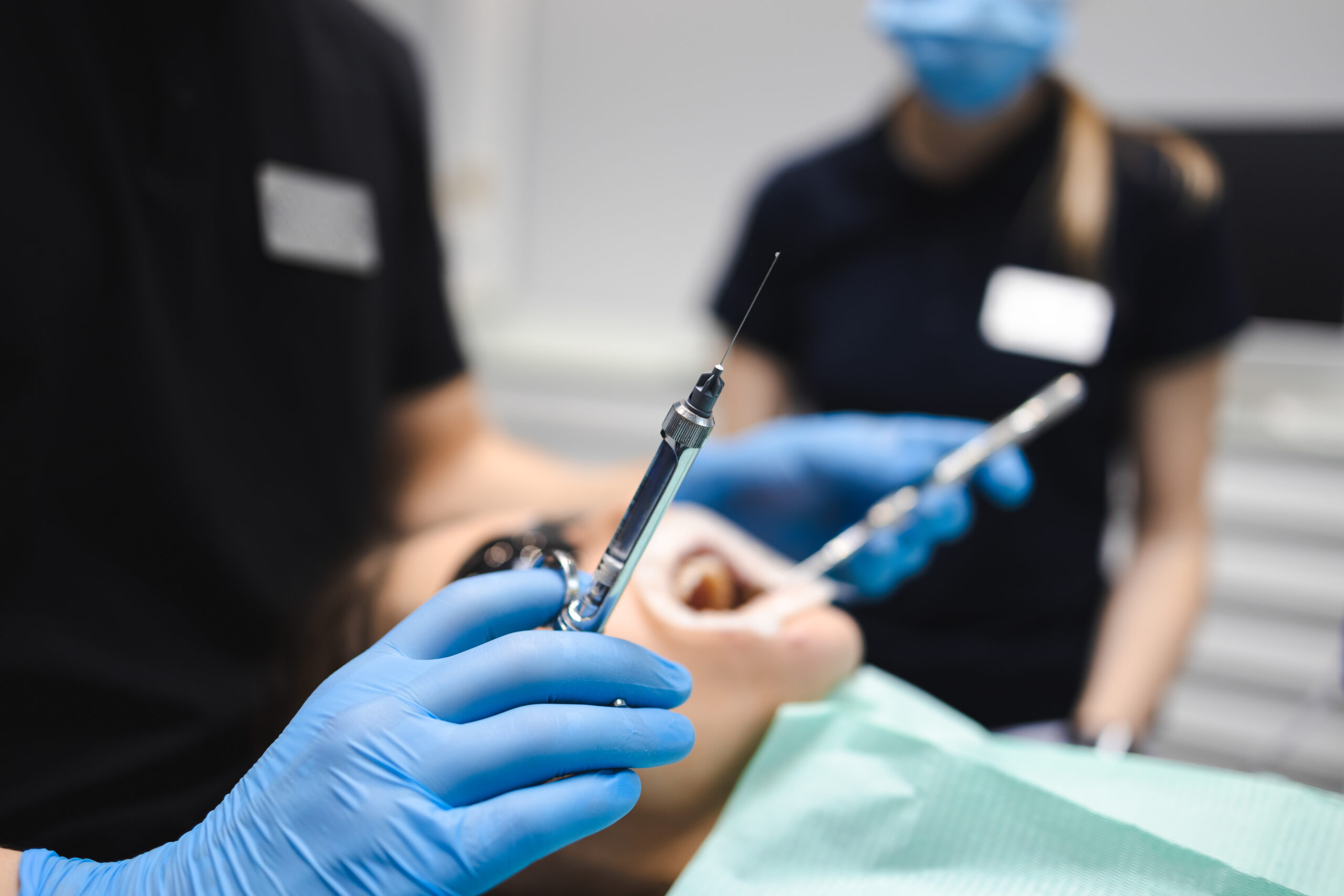Dentist’s Reckless Use of Anesthetic Leads to Suspension from Practice
Case Study
Marc Leffler, DDS, Esq.
May 18, 2023
Reading time: 6 minutes

Background Facts
T was a 67-year-old man who had smoked cigarettes for more than 35 years, using between 1 and 2 packs per day over the years, and he has recently begun “social cigar smoking” when spending time with his friends. He has been repeatedly told by his primary care physician and pulmonologist – the latter of whom has made a diagnosis of COPD (chronic obstructive pulmonary disease) – that his shortness of breath when climbing even 1 flight of stairs will not improve unless he stops his smoking habit and begins a guided program of exercise. T has taken no steps in this regard.
When T presented to his long-time general dentist for a check-up, he finally decided that he wanted to have his maxillary removable partial denture replaced with one 5-unit fixed bridge and another 3-unit bridge. What had been holding him back was his fear of the procedure, but Dr. E assured him that he would be relaxed during the preparation and impression visit by taking an oral dose of a benzodiazepine some 30-45 minutes before treatment, and breathing “laughing gas” by nasal mask while the work took place. Dr. E was permitted by the State in which he practiced to prescribe oral sedatives, so he wrote such a prescription for T to fill and take prior to his upcoming treatment visit. On an updated medical history form, T disclosed his COPD diagnosis and his shortness of breath, but he did not answer the question asking about tobacco use, and Dr. E did not follow up in that regard nor with respect to his stated breathing issues.
Approximately 40 minutes after T swallowed the sedative pill, he sat in Dr. E’s dental chair, where the dental assistant placed a nasal mask with a 6 liter/minute flow of 70% nitrous oxide/30% oxygen. Dr. E came into the treatment room several minutes later, to find T supine in the chair and “very drowsy”. Dr. E gave infiltrations of local anesthesia, waited until T no longer responded to sharp stimuli placed on the gingiva, and began to prepare the abutment teeth for crowns. Dr. E became concerned when he noticed T’s lips taking on a cyanotic appearance, so he tried to stimulate his patient by trying to engage him in conversation, but T was minimally responsive, to the point that the assistant said, “now that’s a relaxed patient”.
Despite T being somewhat uncomfortable with his patient’s minimal responsiveness, he continued the treatment without any changes. Not until T failed to respond at all, to Dr. E’s loudly talking to him and to the applying of a sharp instrument to an un-anesthetized area, did Dr. E realize that T was not breathing normally; he instructed his assistant to call 911.
EMS arrived shortly thereafter to find T “barely breathing”. The EMS crew took over care of T and immediately dialed the N2O/O2 delivery system from its 70/30 mixture to 100% O2, while placing a pulse oximetry monitor which showed an spO2 of 75%. The dental chair was brought to an upright position, at which time a full-face mask and Ambu bag replaced the nasal mask, so that positive pressure oxygen could be delivered if needed. On the order of the physician at the local hospital ED, with whom the EMS team made contact and to whom T’s EKG strips, oxygen saturation levels, blood pressure, and pulse and respiration rates were forwarded, Flumazenil was administered intravenously, with the intention of reversing the effects of the sedative.
T was transported to the hospital, without the need for positive pressure oxygen delivery. As T arrived in the ED, his responsiveness level was visibly improved, with objective parameters showing overall positive progress as well. For precautionary reasons, especially due to T’s age and respiratory disease, he was monitored for 24 hours before being discharged home, by which time he was physiologically stable.
Legal Action
Given that T fully recovered from the episode without sequelae, both attorneys he contacted regarding a potential lawsuit against Dr. E declined to take his case. However, he filed a disciplinary complaint with the State Dental Board, attaching copies of records from Dr. E, EMS, and the hospital. Upon notification by the Board of its investigation, Dr. E sought and received legal representation through his professional liability insurance policy.
After a full set of hearings at which Dr. E appeared with his attorney, the Board levied stiff sanctions against him based upon his actions in treating T: he was fined, suspended from practice for 6 months, and required to take substantial amounts of Board-approved coursework before being permitted to reapply for a permit which would again allow him to administer any enteral or inhalational medication which might alter a patient’s level of consciousness.
Takeaways
There is a general perception among dentists that N2O/O2 is a drug combination that can freely be given without much consequence, but the circumstances involved in this case study speak otherwise: while N2O/O2 is generally very safe, it warrants the respect that its potential side effects dictate. As the Board pointed out in its detailed and critical report, Dr. E’s errors began with permitting his assistant to start the administration outside of his presence, who failed to initially saturate T with 100% oxygen before titrating nitrous oxide into the mixture; Dr. E never changed the relative percentages of the inhaled agents, even when T became cyanotic and his level of responsiveness dropped off considerably. Only when the EMS team arrived and took control of the patient were the necessary alterations made.
The Board then addressed Dr. E’s blatant monitoring failures, which created his ignorance of the developing problem, stating that Dr. E ignored the facts that T had COPD and that T’s likely primary respiratory drive was hypoxic (oxygen lack) rather than hypercapnic (carbon dioxide excess), and instead approached the treatment of T as though he were a healthy patient. T was not monitored by Dr. E for pulse oximetry, blood pressure, pulse rate, respiration rate, or EKG. In this same regard, the Board was critical of the fact that Dr. E demonstrated his lack of awareness of T’s conditions, and that his failure to act timely and appropriately exacerbated an already tenuous situation brought on by him, as compared with external factors over which he had no control.
The final issue addressed focused on the oral administration of a benzodiazepine, a class of drugs frequently used and often without complication. But again, simply because a medication is routinely and safely used does not mean that it is without risk. Here, a patient with ongoing respiratory disease was given a drug which depresses respiratory drive, in conjunction with inhalation agents which were not applied properly, while placed into a position which was gravitationally unfavorable for respiration.
While some jurisdictions place stringent educational and resuscitative requirements on dentists delivering consciousness- and respiratory-altering drugs, others are less strict. Regardless of what statutes may dictate, the obligation to patients to “do no harm” prevails. So while a patient might be excessively nervous about undergoing certain dental procedures, the “cost” of relaxation, especially in medically-compromised patients, can override patient desire, which applies to procedure choices and the modes by which procedures are carried out. Patients may certainly decide what they do not want in terms of treatment, but they cannot be permitted to dictate what a dentist should or must do for them.
T did not institute a dental malpractice lawsuit against Dr. E, but the effects of the administrative action which he brought instead had arguably far more reaching and impactful results. Dentists, and their patients, are well served when dentists perform procedures for which they are properly trained and able to respond to untoward events which might arise from those procedures.
Note that this case presentation includes circumstances from several different closed cases, in order to demonstrate certain legal and risk management principles, and that identifying facts and personal characteristics were modified to protect identities. The content within is not the original work of MedPro Group but has been published with consent of the author. Nothing contained in this article should be construed as legal, medical, or dental advice. Because the facts applicable to your situation may vary, or the laws applicable in your jurisdiction may differ, please contact your personal or business attorney or other professional advisors if you have any questions related to your legal or medical obligations or rights, state or federal laws, contract interpretation, or other legal questions.
Additional Risk Tips content

IAN Injury After Local Anesthesia: Legal and Clinical Takeaways
Explore a real-world dental malpractice case involving inferior alveolar nerve (IAN) injury after local anesthesia. Learn key risk management principles, the role of informed consent, and how deposition testimony can influence case outcomes.

Canceled Joint Replacement Results from Dentist’s Lack of Awareness
Learn how a dentist’s lack of awareness of new protocols can lead to major inconveniences for a patient.

Difficult Patient Sues Dentist After Improper Dismissal and Jousting
This article explores a scenario where a dentist faces a malpractice claim and board complaint after improperly dismissing a difficult patient. Learn the essential steps for proper patient dismissal to protect your practice and license.
This document does not constitute legal or medical advice and should not be construed as rules or establishing a standard of care. Because the facts applicable to your situation may vary, or the laws applicable in your jurisdiction may differ, please contact your attorney or other professional advisors if you have any questions related to your legal or medical obligations or rights, state or federal laws, contract interpretation, or other legal questions.
MedPro Group is the marketing name used to refer to the insurance operations of The Medical Protective Company, Princeton Insurance Company, PLICO, Inc. and MedPro RRG Risk Retention Group. All insurance products are underwritten and administered by these and other Berkshire Hathaway affiliates, including National Fire & Marine Insurance Company. Product availability is based upon business and/or regulatory approval and/or may differ among companies.
© MedPro Group Inc. All rights reserved.